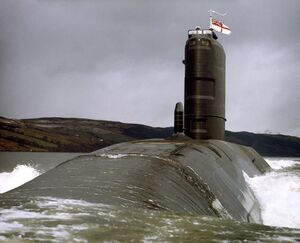اتفاقية الدفاع المتبادل الأمريكية-البريطانية 1958
| اتفاق بين حكومة الولايات المتحدة الأمريكية وحكومة المملكة المتحدة لبريطانيا العظمى وأيرلندا الشمالية للتعاون بشأن استخدامات الطاقة الذرية لأغراض الدفاع المتبادل | |
|---|---|
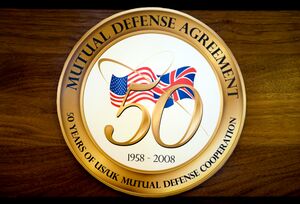 شعار للاحتفالات بالذكرى الخمسين للمعاهدة في عام 2008 | |
| وُقـِّعت | 3 يوليو 1958 |
| المكان | واشنطن العاصمة |
| سارية منذ | 4 أغسطس 1958 |
| انتهاء الصلاحية | 31 ديسمبر 2024 |
| الموقعون | جون فوستر دالاس (الولايات المتحدة) صامويل هود، 6 ڤيكونت هود (المملكة المتحدة) |
اتفاقية الدفاع المشترك بين الولايات المتحدة والمملكة المتحدة لعام 1958 ، أو اتفاقية الدفاع المتبادل بين المملكة المتحدة والولايات المتحدة، هي معاهدة ثنائية بين الولايات المتحدة والمملكة المتحدة بشأن التعاون في الأسلحة النووية . الاسم الكامل للمعاهدة هو اتفاقية بين حكومة الولايات المتحدة الأمريكية وحكومة المملكة المتحدة لبريطانيا العظمى وأيرلندا الشمالية للتعاون بشأن استخدامات الطاقة الذرية لأغراض الدفاع المشترك. يسمح للولايات المتحدة والمملكة المتحدة بتبادل المواد والتكنولوجيا والمعلومات النووية. لدى الولايات المتحدة اتفاقيات تعاون نووي مع دول أخرى، بما في ذلك فرنسا ودول حلف الناتو الأخرى، لكن هذه الاتفاقية هي الأكثر شمولاً إلى حد بعيد. بسبب القيمة الإستراتيجية للاتفاقية بالنسبة لبريطانيا، أطلق عليها هارولد ماكميلان ( رئيس الوزراء الذي ترأس دخول المملكة المتحدة إلى الاتفاقية) "الجائزة الكبرى".[1]
تم التوقيع على المعاهدة في 3 يوليو 1958 بعد أن صدم الاتحاد السوڤيتي الأمريكي بإطلاق سپوتنك في 4 أكتوبر 1957، وكان برنامج القنبلة الهيدروجينية البريطاني قد اختبر بنجاح جهازًا نوويًا حراريًا في اختبار عملية جرابل في 8 نوفمبر. أثبتت العلاقة الخاصة أنها مفيدة للطرفين، لكنها لم تكن أبدًا علاقة متساوية بعد الحربين العالميتين لأن الولايات المتحدة كانت (ولا تزال) أكبر من بريطانيا، عسكريًا واقتصاديًا. سرعان ما أصبحت بريطانيا معتمدة على الولايات المتحدة في الحصول على أسلحتها النووية لأنها تفتقر إلى الموارد اللازمة لإنتاج مجموعة من التصاميم. سمحت المعاهدة بتزويد بريطانيا بالأسلحة النووية الأمريكية من خلال المشروع E لاستخدامها من قبل سلاح الجو الملكي وجيش نهر الراين البريطاني.
نصت المعاهدة على بيع المملكة المتحدة لمحطة دفع غواصة نووية كاملة، بالإضافة إلى تزويدها باليورانيوم المخصب لمدة عشر سنوات لتزويده بالوقود. كما تم الحصول على مواد نووية أخرى من الولايات المتحدة بموجب المعاهدة. تم إرسال حوالي 5.4 طن من البلوتونيوم المنتج في المملكة المتحدة إلى الولايات المتحدة مقابل 6.7 كيلوجرام من التريتيوم و 7.5 طن من اليورانيوم عالي التخصيب (HEU ) بين عامي 1960 و 1979، ولكن الكثير من اليورانيوم عالي التخصيب لم يستخدم للأسلحة ولكن كوقود للأسطول المتنامي من الغواصات النووية البريطانية. مهدت المعاهدة الطريق لاتفاقية مبيعات پولاريس، وحصلت البحرية الملكية في النهاية على أنظمة أسلحة كاملة، باستخدام برنامج پولاريس البريطاني وبرنامج ترايدنت النووي باستخدام الصواريخ الأمريكية مع الرؤوس الحربية النووية البريطانية.
تم تعديل المعاهدة وتجديدها تسع مرات. آخر تجديد تم تمديده حتى 31 ديسمبر 2024.
. . . . . . . . . . . . . . . . . . . . . . . . . . . . . . . . . . . . . . . . . . . . . . . . . . . . . . . . . . . . . . . . . . . . . . . . . . . . . . . . . . . . . . . . . . . . . . . . . . . . . . . . . . . . . . . . . . . . . . . . . . . . . . . . . . . . . . . . . . . . . . . . . . . . . . . . . . . . . . . . . . . . . . . .
الخلفية
اتفاقية كيبيك
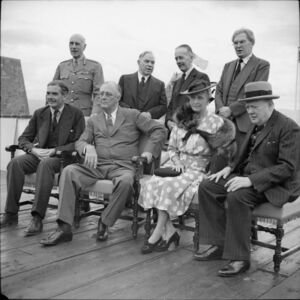
خلال الجزء الأول من الحرب العالمية الثانية، كان لدى بريطانيا مشروع أسلحة نووية، أطلق عليه اسم سبائك الأنابيب.[2] في مؤتمر الرباعي في أغسطس 1943، وقع رئيس وزراء المملكة المتحدة، ونستون تشرشل، ورئيس الولايات المتحدة، فرانكلين روزفلت، اتفاقية كيبيك، التي دمجت سبائك الأنابيب مع مشروع منهاتن لإنشاء مشروع بريطاني وأمريكي وكندي مشترك.[3] أنشأت اتفاقية كيبيك لجنة السياسات المشتركة وصندوق التنمية المشترك لتنسيق جهودهما.[4] شارك العديد من كبار العلماء البريطانيين في مشروع منهاتن.[5]
امتد كل من التعاون التجاري والعسكري إلى فترة ما بعد الحرب بعد مذكرة هايد بارك في سبتمبر 1944،[6] لكن روزفلت توفي في 12 أبريل 1945، المذكرة لم تكن ملزمة للإدارات اللاحقة.[7] في الواقع، كانت المذكرة قد فُقدت. عندما أثار المشير الميدانيالسير هنري ميتلاند ويلسون الأمر في اجتماع لجنة السياسة المشتركة في يونيو 1945، لم يتم العثور على النسخة الأمريكية.[8] نص اتفاق كيبيك على عدم استخدام الأسلحة النووية ضد دولة أخرى دون موافقة متبادلة. في 4 يوليو ،أعطى ويلسون موافقة بريطانية على استخدام الأسلحة النووية ضد اليابان.[9] في 8 أغسطس، أرسل رئيس الوزراء، كلمنت أتلي، رسالة إلى الرئيس هاري ترومان أشاروا فيها إلى أنفسهم بأنهم "رؤساء الحكومات التي تسيطر على هذه القوة العظيمة".[10][11]
إدارة ترومان
كانت الحكومة البريطانية على ثقة من أن الولايات المتحدة ستستمر في مشاركة التكنولوجيا النووية، والتي اعتبرتها اكتشافًا مشتركًا.[10] في 9 نوفمبر 1945 ،ذهب أتلي ورئيس وزراء كندا، ماكنزي كينگ، إلى واشنطن العاصمة للتشاور مع ترومان حول التعاون المستقبلي في مجال الأسلحة النووية والطاقة النووية.[12][13] تم التوقيع على مذكرة نوايا في 16 نوفمبر 1945 جعلت كندا شريكًا كاملاً واستبدلت شرط اتفاق كيبيك "بالموافقة المتبادلة" قبل استخدام الأسلحة النووية بمذكرة "للتشاور المسبق". كان يجب أن يكون هناك "تعاون كامل وفعال في مجال الطاقة الذرية" ،ولكن سرعان ما خاب أمل البريطانيين[14] لأنه كان فقط "في مجال البحث العلمي الأساسي". [15][16]
تم إنهاء التعاون التقني بموجب قانون الطاقة الذرية للولايات المتحدة لعام 1946 (قانون مكماهون)، والذي منع تمرير "البيانات المقيدة" إلى الحلفاء الأمريكيين تحت وطأة الموت.[17] نتج ذلك جزئيًا عن اعتقال الفيزيائي البريطاني Alan Nunn May بتهمة التجسس في فبراير 1946 أثناء مناقشة التشريع.[18] خوفًا من عودة ظهور الانعزالية الأمريكية وفقدان بريطانيا مكانتها كقوة عظمى، استأنفت الحكومة البريطانية جهود التنمية الخاصة بها،[19] التي يُطلق عليها الآن اسم أبحاث شديدة الانفجار.
بحلول نهاية عام 1947، تم تخزين 1900 طن من خام اليورانيوم من الكونغو البلجيكية لحساب صندوق التنمية المشترك في سبرينگ فيلدز، بالقرب من بريستون في لنكشر، كجزء من اتفاقية المشاركة في زمن الحرب، جنبًا إلى جنب مع 1350 طن للاستخدام البريطاني. للوصول إلى المخزون الخاص بمشروع الأسلحة النووية الخاص بهم ، فتح الأمريكيون مفاوضات أسفرت عن اتفاق ڤيڤيندي،[20] تم توقيعه في 7 يناير 1948، وإنهاء جميع الاتفاقيات السابقة رسميًا ،بما في ذلك اتفاقية كيبيك. أزال الحق البريطاني في التشاور بشأن استخدام الأسلحة النووية؛[21] سمح بمشاركة محدودة للمعلومات التقنية بين الولايات المتحدة وبريطانيا وكندا [22][23] واستمر في لجنة السياسة المشتركة وصندوق التنمية المشترك على الرغم من تغيير اسم الأخير إلى وكالة التنمية المشتركة.[24][25]
في عام 1949، عرض الأمريكيون جعل القنابل الذرية في الولايات المتحدة متاحة لبريطانيا لاستخدامها إذا وافق البريطانيون على تقليص برنامج القنبلة الذرية.[26] كان هذا من شأنه أن يمنح بريطانيا أسلحة نووية في وقت أقرب بكثير من الموعد المستهدف في أواخر عام 1952.[27] سيتم تخزين مكونات القنبلة التي تتطلبها خطط الحرب فقط في المملكة المتحدة، وسيتم الاحتفاظ بالباقي في الولايات المتحدة وكندا.[28] وقد رفض البريطانيون العرض على أساس أنه لا "يتوافق مع مكانتنا كقوة من الدرجة الأولى للاعتماد على الآخرين للحصول على أسلحة بهذه الأهمية القصوى".[29]
كعرض مضاد،[30] اقترح البريطانيون تقييد البرنامج البريطاني مقابل القنابل الأمريكية. معارضة المسؤولين الأمريكيين الرئيسيين، بما في ذلك لويس شتراوس من لجنة الطاقة الذرية الأمريكية (AEC)، وأعضاء مجلس الشيوخ بورك ب. هيكنلوبر وآرثر ڤاندنبرگ من اللجنة المشتركة للطاقة الذرية (JCAE)، إلى جانب المخاوف الأمنية التي أثيرت بحلول 2 فبراير في عام 1950، أدى توقيف الفيزيائي البريطاني كلاوس فوكس بتهمة التجسس الذري إلى إسقاط الاقتراح.[31] عزز انشقاق يونيو 1951 لدونالد مكلين، الذي عمل كعضو بريطاني في لجنة السياسة المشتركة من يناير 1947 إلى أغسطس 1948، عدم ثقة الأمريكيين في الترتيبات الأمنية البريطانية. [32]
إدارة أيزنهاور
The first British atomic bomb was successfully tested in Western Australia in Operation Hurricane on 3 October 1952,[33] but although it was more advanced than the American bombs of 1946, Britain was still several years behind in nuclear weapons technology.[34] On 1 November, the United States conducted Ivy Mike, the first nuclear test of a true thermonuclear device (also known as a hydrogen bomb).[35] The JCAE saw little benefit for the US from sharing technology with Britain.[36][37] The Soviet Union responded to Ivy Mike with the test of Joe 4, a boosted fission weapon on 12 August 1953.[36] That prompted President Dwight Eisenhower, who was inaugurated in January 1953, to inform the US Congress that the McMahon Act, which he considered a "terrible piece of legislation" and "one of the most deplorable incidents in American history of which he personally felt ashamed", was obsolete.[38]
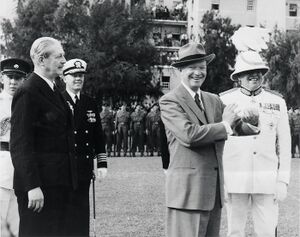
At the three-power Bermuda Conference in December 1953, Eisenhower and Churchill,[39] who had become prime minister again on 25 October 1951,[40] discussed the possibility of the United States giving Britain access to American nuclear weapons in wartime,[39] which came to be called Project E.[38] There were technical and legal issues that had to be overcome before American bombs could be carried in British aircraft. The Americans would have to disclose their weights and dimensions, and their delivery would require data concerning their ballistics. Further down the track would also be issues of custody, security and targeting. The release of such information was restricted by the McMahon Act.[41]
It was amended on 30 August 1954 by the Atomic Energy Act of 1954, which allowed for greater exchange of information with foreign nations[42] and paved the way for the Agreement for Co-operation Regarding Atomic Information for Mutual Defence Purposes, which was signed on 15 June 1955.[43] On 13 June 1956, another agreement was concluded for the transfer of nuclear submarine propulsion technology to Britain, which saved the British government millions of pounds in research and development costs. It precipitated a row with the JCAE over whether that was permitted under the Atomic Energy Act of 1954 and whether Britain met the security standards set by the 1955 agreement. With the 1956 presidential election approaching, Eisenhower was forced to rescind the offer.[44]
The October 1956 Suez Crisis brought relations between Britain and the United States to a low ebb.[45] Eisenhower met with the new British prime minister, Harold Macmillan, in Bermuda in March 1957 and raised the possibility of basing US intermediate range ballistic missile (IRBM) systems in the UK.[46] This came to be called Project Emily.[47] There were also discussions on exchanging nuclear submarine propulsion technology for information on the British Calder Hall nuclear power plant, allowing the United Kingdom Atomic Energy Authority (UKAEA) to purchase uranium ore from Canada and co-ordinating the war plans of RAF Bomber Command with those of the Strategic Air Command.[48]
Although the IRBM negotiations pre-dated the Suez Crisis, the British government touted the IRBM deal as a demonstration that the rift had been healed.[49] The British hydrogen bomb programme attempted to detonate a thermonuclear device in the Operation Grapple test series at Christmas Island in the Pacific.[50] The test series was facilitated by the UA, which also claimed the island.[51] Although the first tests were unsuccessful,[52] the Grapple X test on 8 November achieved the desired result.[50][53]
المفاوضات
أزمة سپوتنك
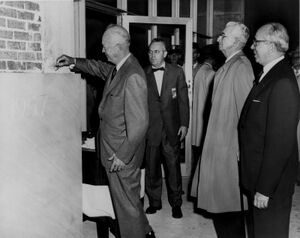
The successful development of British thermonuclear weapons came at an opportune moment to renew negotiations with the Americans. The Soviet Union's launch of Sputnik 1, the world's first artificial satellite, on 4 October 1957, came as a tremendous shock to the American public, which had trusted that American technological superiority ensured their invulnerability. Suddenly, there was now incontrovertible proof that in at least some areas, the Soviet Union was actually ahead. In the widespread calls for action in response to the Sputnik crisis, officials in the United States and Britain seized an opportunity to mend their relationship.[54] At the suggestion of Harold Caccia, the British Ambassador to the United States, Macmillan wrote to Eisenhower on 10 October to urge for both countries pool their resources,[55] as Macmillan put it, to meet the Soviet challenge on every front, "military, economic and political".[56]
Macmillan flew to Washington, DC, for talks on 25 October.[57] He had concerns that the disastrous 10 October Windscale fire might prove a stumbling block in negotiations,[58] as it might reflect badly on British expertise and provide ammunition for opponents of closer co-operation with the British. He ordered extra copies of the report into the fire to be destroyed and for the printers to destroy their type.[59] He immediately sensed how shaken the Americans had been by Sputnik,[54] which placed the Eisenhower administration under great public pressure to act on the deployment of IRBMs by a shocked and distraught nation.[60]
Eisenhower and Macmillan agreed to form a study group headed by Sir Richard Powell, the Permanent Secretary to the Ministry of Defence, and Donald A. Quarles, the United States Deputy Secretary of Defense, to consider how the deployment of IRBMs to Britain might be expedited.[57] Another study group, under Strauss and Sir Edwin Plowden, the head of the UKAEA, would investigate nuclear co-operation and the exchange of nuclear information.[58] The personal relationship developed between Plowden and Strauss would be crucial in converting the latter over to the idea of providing information to Britain.[61]
By December, most of the issues with the IRBM negotiations had been ironed out,[62] and a formal agreement was drawn up on 17 December, but it was not until the end of the month that it was definitely determined that Britain would receive Thor, not Jupiter, missiles.[63]
However, the nuclear submarine propulsion effort was running into trouble. Under the July 1956 agreement and a February 1957 directive from Eisenhower, Royal Navy officers had been assigned to study the US Navy's nuclear submarine programme. By October 1957, its head, Rear Admiral Hyman G. Rickover, felt that their questions were slowing the deployment of the Polaris submarine-launched IRBM at a critical time. He feared that any delay might cause Congress to favour land-based missiles. By December, the British liaison officers were complaining of slow response to their questions. Rickover proposed that Westinghouse be permitted to sell the Royal Navy a nuclear submarine reactor, which would allow it to immediately proceed with building its own nuclear-powered submarine. The British government endorsed this idea, as it would save it a great deal of money.[64][65]
. . . . . . . . . . . . . . . . . . . . . . . . . . . . . . . . . . . . . . . . . . . . . . . . . . . . . . . . . . . . . . . . . . . . . . . . . . . . . . . . . . . . . . . . . . . . . . . . . . . . . . . . . . . . . . . . . . . . . . . . . . . . . . . . . . . . . . . . . . . . . . . . . . . . . . . . . . . . . . . . . . . . . . . .
تعديل قانون مكماهون
For their part, the British wanted the McMahon Act's restrictions on nuclear co-operation to be relaxed. They wanted to know the weight, dimensions, fusing and firing sequences, safety features, and in-flight procedures. That information would allow American bombs to be carried in British V-bombers and American warheads to be fitted to British Blue Streak missiles.[64] That could save millions of pounds and avoid domestic political complications if Britain had to persist with nuclear testing during an international moratorium.[61] While the British knew what they wanted, there was no consensus among the Americans as to what they wanted to provide.[64] US Secretary of State John Foster Dulles was concerned that a special relationship with Britain might complicate US relationships with its other allies.[66] Strauss, in particular, felt that a proposal to give hydrogen bomb secrets to the British would likely not get past the JCAE, and counselled drafting amendments that were sufficiently vague as to give the president the authority that he needed without arousing its ire.[64] Eisenhower declared that the US and the UK were "interdependent" and pledged to ask Congress to amend the McMahon Act.[67]
Crucially, he managed to secure the support of Carl T. Durham, the chairman of the JCAE. Eisenhower met with congressional leaders on 3 December 1957 and pressed for more discretion to co-operate with all America's NATO allies, not just Britain.[68] Indeed, the administration negotiated agreements with Australia, Canada and NATO.[69] Eisenhower did not yet have wholehearted support for the proposal, but outright opposition from US Senator Clinton Anderson failed to attract much support.[68] On 27 January 1958, Strauss sent Durham the administration's proposed legislative changes,[69] and the JCAE Subcommittee on Agreements for Cooperation, chaired by Senator John Pastore, held hearings from 29 to 31 January. Quarles and Major General Herbert Loper, the Assistant to the Secretary of Defense for Atomic Energy Affairs, were forced to deal with pointed questions about nuclear proliferation.[70] British information security, or the lack thereof no longer seemed so important now that the Soviet Union was apparently ahead and the UK had independently developed the hydrogen bomb,[71] but the JCAE objected to the terms of the proposed deal to trade British uranium-235 for US plutonium under which the US would pay USD$30 per gram for plutonium that cost $12 per gram to produce in the UK.[72]
The amendments were passed by the US House of Representatives on 19 June but not without changes that now limited exchanges of nuclear weapons data to nations that had made substantial progress in the field. The same restriction applied to the actual transfer of non-nuclear components of nuclear weapons. American nuclear weapons were to remain under US custody and could not be turned over to allies except in wartime. The sale of nuclear reactors for submarines and nuclear fuel for them and other military reactors was permitted. Only the UK qualified as a nation that had made substantial progress.[73] The bill passed Congress on 30 June 1958 and was signed into law by Eisenhower on 2 July 1958.[74]
The 1958 US–UK Mutual Defence Agreement was signed by Dulles and Samuel Hood, the British Minister in Washington, DC, on 3 July[75] and was approved by Congress on 30 July.[76]
التنفيذ
التفاصيل
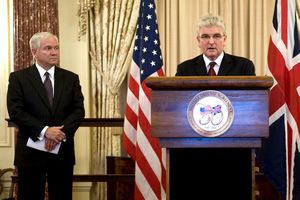
تمكن الاتفاقية الولايات المتحدة والمملكة المتحدة من تبادل معلومات سرية بهدف تحسين "قدرة تصميم وتطوير وتصنيع السلاح الذري" لكل طرف.[75] في حين أن الولايات المتحدة لديها اتفاقيات تعاون نووي مع دول أخرى، بما في ذلك فرنسا وبعض دول الناتو، إلا أن أياً منها لا يشبه في نطاق اتفاقية الدفاع المشترك بين الولايات المتحدة والمملكة المتحدة.[77] Macmillan called it "the Great Prize".[1]
تناولت المادة 2 من المعاهدة التطوير المشترك لخطط الدفاع؛ التدريب المتبادل للأفراد على استخدام الأسلحة النووية والدفاع عنها؛ تبادل المعلومات الاستخبارية وتقييم قدرات العدو؛ تطوير أنظمة التوصيل النووية والبحث والتطوير وتصميم المفاعلات العسكرية. [78] دعت المعاهدة إلى تبادل "المعلومات السرية المتعلقة بالأسلحة الذرية عندما يقرر الطرف المتصل، بعد التشاور مع الطرف الآخر، أن إبلاغ مثل هذه المعلومات ضروري لتحسين تصميم الأسلحة الذرية وقدرات تطويرها وتصنيعها".[75] ستنقل الولايات المتحدة معلومات حول الأسلحة الذرية التي كانت مشابهة للأسلحة الذرية للمملكة المتحدة. بالنسبة للمستقبل القريب، قد يستبعد ذلك المعلومات المتعلقة بالأسلحة النووية الحرارية.[79] كما تغطي الاتفاقية مسائل الاستخبارات السرية. لم تنشر حكومة المملكة المتحدة هذه الأقسام "بسبب ضرورة السرية الشديدة وبسبب استخدام مثل هذه المعلومات لدول أخرى قد تكون نووية. وبعبارة أخرى، قد تساعد في الانتشار".[80]
نصت المادة 3 على بيع المملكة المتحدة لمحطة دفع غواصة نووية كاملة، بالإضافة إلى اليورانيوم اللازم لتزويدها بالوقود لمدة عشر سنوات.[78] بسبب المخاوف التي أعربت عنها JCAE ، ستحدد AEC السعر الذي ستدفعه بريطانيا مقابل اليورانيوم عالي التخصيب (HEU).[79] لم تسمح المعاهدة في الأصل بإعطاء مكونات غير نووية للأسلحة النووية لبريطانيا. تم تعديله في 7 مايو 1959 لمنح بريطانيا حق الوصول إلى المكونات غير النووية [76]والسماح بنقل المواد النووية الخاصة مثل البلوتونيوم واليورانيوم عالي التخصيب والتريتيوم.[81] مهدت المعاهدة الطريق لاتفاقية مبيعات Polaris اللاحقة،[82] والتي تم توقيعها في 6 أبريل 1963.[83] كانت الاتفاقيتان "حجر الزاوية في العلاقة النووية بين المملكة المتحدة والولايات المتحدة لما يقرب من 60 عامًا". [78]
تطوير الأسلحة النووية
The AEC invited the British government to send representatives to a series of meetings in Washington, DC, on 27 and 28 August 1958 to work out the details. The US delegation included Willard Libby, AEC deputy chairman; Loper; Brigadier General Alfred Starbird, AEC Director of Military Applications; Norris Bradbury, director of the Los Alamos National Laboratory; Edward Teller, director of the Lawrence Livermore Laboratory; and James W. McRae, president of the Sandia Corporation. The British representatives were Sir Frederick Brundrett, the Chief Scientific Adviser to the Ministry of Defence, and Victor Macklen from the Ministry of Defence; and William Penney, William Cook and E. F. Newly from the Atomic Weapons Research Establishment at Aldermaston. The Americans disclosed the details of nine of their nuclear weapon designs: the Mark 7, Mark 15/39, Mark 19, Mark 25, Mark 27, Mark 28, Mark 31, Mark 33 and Mark 34. In return, the British provided the details of seven of theirs, including Green Grass; Pennant, the boosted device which had been detonated in the Grapple Z test on 22 August; Flagpole, the two-stage device scheduled for 2 September; Burgee, scheduled for 23 September; and the three-stage Halliard 3. The Americans were impressed with the British designs, particularly with Halliard 1, the heavier version of Halliard 3. Cook, therefore, changed the Grapple Z programme to fire Halliard 1 instead of Halliard 3.[84] Macmillan noted in his diary with satisfaction:
in some respects we are as far, and even further, advanced in the art than our American friends. They thought interchange of information would be all give. They are keen that we should complete our series, especially the last megaton, the character of which is novel and of deep interest to them.[85]
An early benefit of the agreement was to allow the UK to "Anglicise" the W28 nuclear warhead as the Red Snow warhead for the Blue Steel missile.[86] The British designers were impressed by the W28, which was not only lighter than the British Green Grass warhead used in Yellow Sun but also remarkably more economical in its use of expensive fissile material. The Yellow Sun Mark 2 using Red Snow cost £500,000 compared with £1,200,000 for the Mark 1 with Green Grass.[87] A 1974 CIA proliferation assessment noted: "In many cases [Britain's sensitive technology in nuclear and missile fields] is based on technology received from the US and could not legitimately be passed on without US permission".[88] The UK National Audit Office noted that most of the UK Trident programme warhead development and production expenditure had been incurred in the US, which supplied special materials and "certain warhead-related components and services".[89][90] There is evidence that the warhead design of the British Trident system is similar to or even based upon the US W76 warhead fitted in US Navy Trident missiles, with design and blast model data supplied to the UK.[91][92]
Britain soon became dependent on the United States for its nuclear weapons, as it lacked the resources to produce a range of designs.[93] The treaty allowed the UK to receive US nuclear weapons for the Royal Air Force (RAF) and British Army of the Rhine (BAOR) under Project E.[94] Similar custody arrangements were made for the Thor missiles supplied under Project Emily.[95] The UK was able to carry out underground nuclear tests at the US Nevada Test Site, where the first British test took place on 1 March 1962.[96] British nuclear testing in the United States continued until it was abruptly halted by President George H. W. Bush in October 1992.[97][98] Major subcritical nuclear tests continued to occur, most notably the Etna test in February 2002 and the Krakatau test in February 2006.[99]
مقايضة المواد النووية الخاصة
Under the agreement 5.37 tonnes of UK-produced plutonium was sent to the US in exchange for 6.7 kg of tritium and 7.5 tonnes of HEU between 1960 and 1979. A further 470 kg of plutonium was swapped between the US and the UK for reasons that remain classified.[100] Some of the UK-produced plutonium was used in 1962 by the US for the only known nuclear weapon test of reactor-grade plutonium.[101] The plutonium sent to the US included some produced in UK civil Magnox reactors, and the US gave assurances that the civil plutonium was not used in the US nuclear weapons programme. It was used in civil programmes which included californium production and reactor research.[100]
Some of the fissile materials for the UK Trident warhead were purchased from the US,[90] but much of the HEU supplied by the US was used not for weapons but as fuel for the growing fleet of UK nuclear submarines. Under the treaty, the US supplied the UK with not only nuclear submarine propulsion technology but also a complete S5W pressurised water reactor of the kind used to power the US Skipjack، طراز submarines. That was used in the Royal Navy's first nuclear-powered submarine, إتشإمإس Dreadnought, which was launched in 1960 and commissioned in 1963. The S5W was fuelled by uranium enriched to between 93 and 97 per cent uranium-235.[102] Reactor technology was transferred from Westinghouse to Rolls Royce,[103] which used it as the basis for its PWR1 reactor used in the UK's Valiant, Resolution, Churchill, Swiftsure and Trafalgar submarines.[104]
The UK produced HEU at its facility in Capenhurst, but production for military purposes ceased there in March 1963.[105] Thereafter, uranium oxide was imported from Australia, Canada, Namibia, South Africa, the United States and Zaire and processed into uranium hexafluoride at Springfields. It was then shipped to the US, where it was enriched at the Portsmouth Gaseous Diffusion Plant near Piketon, Ohio. HEU was then flown back to the UK in RAF aircraft.[102] In 1994, with the Portsmouth plant about to close, the treaty was amended with the US requirement to "provide" uranium enrichment services changed to one to "arrange" them.[75] By March 2002, the UK had a stockpile of 21.86 tonnes of HEU, about 80 years' supply for the Royal Navy's nuclear-powered submarines.[106]
. . . . . . . . . . . . . . . . . . . . . . . . . . . . . . . . . . . . . . . . . . . . . . . . . . . . . . . . . . . . . . . . . . . . . . . . . . . . . . . . . . . . . . . . . . . . . . . . . . . . . . . . . . . . . . . . . . . . . . . . . . . . . . . . . . . . . . . . . . . . . . . . . . . . . . . . . . . . . . . . . . . . . . . .
مجموعات العمل المشتركة
Most of the activity under the treaty is information exchange through Joint Working Groups (JOWOG). At least 15 of them were established in 1959.[107] Subjects investigated included
one-point safety, computer codes, metallurgy and fabrication technology for beryllium, uranium and plutonium, corrosion of uranium in the presence of water and water vapour, underground effects tests, outer-space testing, clandestine testing, the technology of lithium compounds, high explosives, deuterium monitors, extinguishing plutonium fires, high-speed cameras, mechanical safing, liquid and solid explosive shock initiation, environmental sensing switches, neutron sources, tritium reservoirs, telemetry, hydrodynamic and shock relations for problems with spherical and cylindrical symmetry, nuclear cross sections, radiochemistry, atomic demolition munitions, warhead hardening, asymmetric detonations, terrorist nuclear threat response, nuclear weapons accidents and waste management.[107]
Between 2007 and 2009, staff of the Atomic Weapons Establishment paid 2,000 visits to US nuclear facilities.[108] اعتبارا من 2014[تحديث] there are also two enhanced collaborations jointly developing capabilities:
- Enhanced Nuclear Safety to develop architectures and technologies related to warhead safety; and
- Warhead Electrical System to develop architectures and technologies for warhead electrical systems.[109]
المنفعة المتبادلة
The Anglo-American special relationship proved mutually beneficial although it has never been one of equals after the World Wars since the US has been far larger than Britain both militarily and economically.[93] Lorna Arnold noted:
The balance of advantage in the exchanges was necessarily in Britain's favour but they were not entirely one-sided. In some areas, notably electronics and high explosives, the British were equal or perhaps even superior, and in many areas they had valuable ideas to contribute, as the American scientists, and notably Teller, appreciated.[110]
A 1985 report by the US State Department's Bureau of Intelligence and Research reported that the US was "profoundly involved and benefited greatly" from the treaty.[111]
التجديد
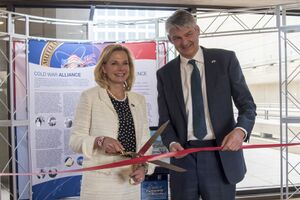
تم تعديل المعاهدة في 7 مايو 1959، و 27 سبتمبر 1968، و 16 أكتوبر 1969، و 22 يونيو 1974، و 5 ديسمبر 1979، و 5 يونيو 1984، و 23 مايو 1994، و 14 يونيو 2004. وكانت معظم التعديلات مجرد تمديد للمعاهدة لمدة خمس أو عشر سنوات أخرى؛ أضاف آخرون تعريفات وأجروا تغييرات طفيفة.[75][112][113] اعتبارًا من عام 2020، كان آخر تجديد في 22 يوليو 2014، لتمديد المعاهدة حتى 31 ديسمبر 2024، مع تغييرات طفيفة على برنامج ترايدنت النووي.[114][115]
جادل الرأي القانوني لعام 2004 الذي حصل عليه مجلس معلومات الأمن البريطاني الأمريكي (BASIC) بأن تجديد المعاهدة ينتهك المادة السادسة من معاهدة عدم انتشار الأسلحة النووية، والتي تتطلب من الموقعين اتخاذ خطوات نحو نزع السلاح النووي، لكن ذلك لم يتم قبوله من قبل البريطانيين. حكومة. في يوليو 2014، البارونة وارسي، وزيرة الدولة الأقدم للشؤون الخارجية وشؤون الكومنولث من 2012 إلى 2014،[116] صرح موقف الحكومة:
نحن ملتزمون بهدف إيجاد عالم خال من الأسلحة النووية ونؤمن إيمانا راسخا بأن أفضل طريقة لتحقيق ذلك هي من خلال نزع السلاح التدريجي عن طريق التفاوض من خلال نهج تدريجي في إطار معاهدة عدم انتشار الأسلحة النووية. تتمتع المملكة المتحدة بسجل قوي في مجال نزع السلاح النووي ولا تزال في طليعة الجهود الدولية للسيطرة على الانتشار، ولإحراز تقدم نحو نزع السلاح النووي متعدد الأطراف. اتفاقية الدفاع المتبادل بين المملكة المتحدة والولايات المتحدة الأمريكية هي، وستظل، في حالة امتثال كامل لالتزاماتنا بموجب معاهدة عدم انتشار الأسلحة النووية.[117]
ملاحظات
- ^ أ ب Macmillan 1971, p. 323.
- ^ Gowing 1964, pp. 108–111.
- ^ Hewlett & Anderson 1962, p. 277.
- ^ Hewlett & Anderson 1962, pp. 285–286.
- ^ Gowing 1964, pp. 236–242.
- ^ Gowing 1964, pp. 340–342.
- ^ Paul 2000, pp. 72–73.
- ^ Hewlett & Anderson 1962, pp. 457–458.
- ^ Gowing 1964, p. 372.
- ^ أ ب Goldberg 1964, p. 410.
- ^ Hewlett & Anderson 1962, pp. 372–373.
- ^ Gott 1963, p. 240.
- ^ Gowing & Arnold 1974a, pp. 73–77.
- ^ Gowing & Arnold 1974a, p. 92.
- ^ Paul 2000, pp. 80–83.
- ^ Hewlett & Anderson 1962, p. 468.
- ^ Gowing & Arnold 1974a, pp. 106–108.
- ^ Gowing & Arnold 1974a, pp. 105–108.
- ^ Gowing & Arnold 1974a, pp. 181–184.
- ^ Gowing & Arnold 1974a, pp. 358–360.
- ^ Botti 1987, pp. 34–35.
- ^ Gowing & Arnold 1974a, pp. 245–254.
- ^ Hewlett & Duncan 1969, pp. 281–283.
- ^ Gowing & Arnold 1974a, pp. 352–353.
- ^ Hewlett & Duncan 1969, p. 285.
- ^ Hewlett & Duncan 1969, pp. 307–308.
- ^ Hewlett & Duncan 1969, p. 310.
- ^ Gowing & Arnold 1974a, pp. 281–283.
- ^ Baylis 1995, p. 75.
- ^ Hewlett & Duncan 1969, pp. 309–310.
- ^ Hewlett & Duncan 1969, pp. 312–314.
- ^ Botti 1987, pp. 74–75.
- ^ Gowing & Arnold 1974b, pp. 493–495.
- ^ Gowing & Arnold 1974b, pp. 474–475.
- ^ Arnold & Pyne 2001, pp. 16–20.
- ^ أ ب Arnold & Pyne 2001, pp. 27–30.
- ^ Gowing & Arnold 1974b, pp. 498–500.
- ^ أ ب Baylis 2008, pp. 429–430.
- ^ أ ب Paul 2000, pp. 200–201.
- ^ Farmelo 2013, pp. 372–375.
- ^ Young 2016, pp. 200–201.
- ^ Botti 1987, pp. 140–141.
- ^ Botti 1987, pp. 147–149.
- ^ Botti 1987, pp. 161–164.
- ^ Botti 1987, pp. 171–174.
- ^ Botti 1987, pp. 174–177.
- ^ Young 2016, pp. 98–99.
- ^ Botti 1987, pp. 180–181.
- ^ Young 2007, p. 8.
- ^ أ ب Baylis 1994, pp. 166–170.
- ^ Botti 1987, pp. 159–160.
- ^ Arnold & Pyne 2001, p. 147.
- ^ Arnold & Pyne 2001, pp. 160–162.
- ^ أ ب Botti 1987, pp. 199–201.
- ^ Arnold & Pyne 2001, p. 199.
- ^ "Foreign Relations of the United States, 1955–1957, Western Europe and Canada, Volume XXVII – Document 306". Office of the Historian, United States Department of State. Retrieved 12 September 2017.
- ^ أ ب Divine 1993, p. 34.
- ^ أ ب Baylis 2008, p. 438.
- ^ Lohr, Steve (2 January 1988). "Britain Suppressed Details of '57 Atomic Disaster: Macmillan feared the loss of U.S. cooperation". The New York Times. p. 3. Retrieved 18 August 2019.
- ^ Divine 1993, pp. 73–74.
- ^ أ ب Baylis 2008, p. 440.
- ^ Baylis 2008, p. 442.
- ^ Wynn 1997, p. 287.
- ^ أ ب ت ث Botti 1987, p. 203.
- ^ Baylis 2008, pp. 441–442.
- ^ Baylis 2008, p. 439.
- ^ Moore 2010, p. 33.
- ^ أ ب Botti 1987, pp. 207–208.
- ^ أ ب Botti 1987, p. 214.
- ^ Botti 1987, pp. 215–219.
- ^ Botti 1987, pp. 224–225.
- ^ Botti 1987, p. 224.
- ^ Botti 1987, pp. 232–233.
- ^ Botti 1987, pp. 234–236.
- ^ أ ب ت ث ج "Agreement between the Government of the United States of America and the Government of the United Kingdom of Great Britain and Northern Ireland for Cooperation on the uses of Atomic Energy for Mutual Defence Purposes" (PDF). Nuclear Threat Initiative. Retrieved 1 June 2017.
- ^ أ ب Botti 1987, p. 238.
- ^ Ellwood, Tobias (24 November 2014). "Military Alliances: Written question – 214429". Hansard. UK Parliament. Retrieved 25 November 2014.
- ^ أ ب ت Mills 2014, p. 3.
- ^ أ ب Botti 1987, pp. 236–237.
- ^ Lord Bach (22 June 2004). "UK-US Mutual Defence Agreement". Hansard. UK Parliament. Archived from the original on 12 March 2007. Retrieved 15 March 2007.
- ^ Moore 2010, pp. 84–85.
- ^ Baylis 2008, pp. 455–456.
- ^ Jones 2017, p. 444.
- ^ Arnold & Pyne 2001, pp. 202–205.
- ^ Macmillan 1971, p. 565.
- ^ Moore 2010, pp. 88–89.
- ^ Moore 2010, pp. 104–105.
- ^ Prospects for Further Proliferation of Nuclear Weapons. Special National Intelligence Estimate. CIA. 23 August 1974. p. 40. SNIE 4-1-74. Archived from the original. You must specify the date the archive was made using the
|archivedate=parameter. http://www.gwu.edu/~nsarchiv/NSAEBB/NSAEBB240/snie.pdf. Retrieved on 20 January 2008. - ^ Plesch, Dan (March 2006). The Future of Britain's WMD. Foreign Policy Centre. p. 15. Archived from the original. You must specify the date the archive was made using the
|archivedate=parameter. http://www.danplesch.net/articles/WMD/WMDMar10FINAL.pdf. Retrieved on 15 March 2007. - ^ أ ب Downey 1987, pp. 3, 10, 18.
- ^ "Britain's Next Nuclear Era". Federation of American Scientists. 7 December 2006. Archived from the original on 6 February 2007. Retrieved 15 March 2007.
- ^ "Stockpile Stewardship Plan: Second Annual Update (FY 1999)" (PDF). United States Department of Energy. April 1998. Archived from the original (PDF) on 25 March 2009. Retrieved 15 March 2007.
- ^ أ ب Botti 1987, pp. 238–241.
- ^ Moore 2010, pp. 114–115.
- ^ Moore 2010, pp. 98–99.
- ^ "UK Mounts First Underground Nuclear Test (UGT)". Atomic Weapons Establishment. Archived from the original on 18 January 2008. Retrieved 15 March 2007.
- ^ Baylis 2008, p. 462.
- ^ Wade 2008, p. 209.
- ^ Wade 2008, p. 210.
- ^ أ ب "Plutonium and Aldermaston – an historical account" (PDF). UK Ministry of Defence. 4 September 2001. Archived from the original (PDF) on 13 December 2006. Retrieved 15 March 2007.
- ^ "Additional Information Concerning Underground Nuclear Weapon Test of Reactor-Grade Plutonium". US Department of Energy. June 1994. Retrieved 15 March 2007.
- ^ أ ب Ritchie 2015, p. 3.
- ^ Moore 2010, p. 35.
- ^ Ritchie 2015, p. 4.
- ^ Moore 2010, pp. 197–199.
- ^ Ritchie 2015, p. 7.
- ^ أ ب Moore 2010, p. 90.
- ^ Mills 2014, p. 5.
- ^ Dunne, Philip (21 October 2014). "Written question 209762: Angus Robertson 26-09-2014". UK Parliament. Retrieved 27 October 2014.
- ^ Arnold & Pyne 2001, p. 215.
- ^ Baylis 2008, p. 461.
- ^ "Treaties in Force" (PDF). United States Department of State. Retrieved 8 September 2017.
- ^ "Disarmament Documentation: Amendment to the 1958 US-UK Mutual Defence Agreement (on nuclear weapons' cooperation), June 2004". Acronym Institute. Retrieved 12 September 2016.
- ^ "UK/US: Amendment to the Agreement for Cooperation on the Uses of Atomic Energy for Mutual Defense Purposes". Foreign and Commonwealth Office. 16 October 2014. Archived from the original on 22 March 2015. Retrieved 22 March 2015.
- ^ Norton-Taylor, Richard (30 July 2014). "UK-US sign secret new deal on nuclear weapons". The Guardian. Retrieved 8 September 2017.
- ^ Townsend, Mark. "Lady Warsi on Palestine, Islam, quitting ... and how to stay true to your beliefs". The Guardian. Retrieved 12 May 2016.
- ^ Mills 2014, p. 10.
المصادر
- Arnold, Lorna; Pyne, Katherine (2001). Britain and the H-bomb. Houndmills, Basingstoke, Hampshire ; New York: Palgrave. ISBN 978-0-230-59977-2. OCLC 753874620.
- Baylis, John (Summer 1994). "The Development of Britain's Thermonuclear Capability 1954–61: Myth or Reality?". Contemporary Record. 8 (1): 159–164. ISSN 1361-9462.
- Baylis, John (1995). Ambiguity and Deterrence: British Nuclear Strategy 1945–1964. Oxford: Clarendon Press. ISBN 0-19-828012-2.
- Baylis, John (June 2008). "The 1958 Anglo-American Mutual Defence Agreement: The Search for Nuclear Interdependence". The Journal of Strategic Studies. 31 (3): 425–466. doi:10.1080/01402390802024726. ISSN 0140-2390. S2CID 153628935.
- Botti, Timothy J. (1987). The Long Wait: the Forging of the Anglo-American Nuclear Alliance, 1945–58. Contributions in Military Studies. New York: Greenwood Press. ISBN 978-0-313-25902-9. OCLC 464084495.
- Cathcart, Brian (1995). Test of Greatness: Britain's Struggle for the Atom Bomb. London: John Murray. ISBN 0-7195-5225-7. OCLC 31241690.
- Divine, Robert A. (1993). The Sputnik Challenge. Oxford: Oxford University Press. ISBN 978-0-19-505008-0. OCLC 875485384.
- Downey, Gordon (29 June 1987). Ministry of Defence and Property Services Agency: Control and Management of the Trident Programme (PDF). -London: Her Majesty's Stationery Office. ISBN 978-0-10-202788-4. OCLC 655304084. Retrieved 12 December 2019.
- Farmelo, Graham (2013). Churchill's Bomb: How the United States Overtook Britain in the First Nuclear Arms Race. New York: Basic Books. ISBN 978-0-465-02195-6. OCLC 858935268.
- Goldberg, Alfred (July 1964). "The Atomic Origins of the British Nuclear Deterrent". International Affairs. 40 (3): 409–429. doi:10.2307/2610825. JSTOR 2610825.
- Gott, Richard (April 1963). "The Evolution of the Independent British Deterrent". International Affairs. 39 (2): 238–252. doi:10.2307/2611300. ISSN 0020-5850. JSTOR 2611300.
- Gowing, Margaret (1964). Britain and Atomic Energy 1939–1945. London: Macmillan. OCLC 3195209.
- Gowing, Margaret; Arnold, Lorna (1974a). Independence and Deterrence: Britain and Atomic Energy, 1945–1952, Volume 1, Policy Making. London: Macmillan. ISBN 0-333-15781-8. OCLC 611555258.
- Gowing, Margaret; Arnold, Lorna (1974b). Independence and Deterrence: Britain and Atomic Energy, 1945–1952, Volume 2, Policy and Execution. London: Palgrave Macmillan. ISBN 0-333-16695-7. OCLC 946341039.
- Hewlett, Richard G.; Anderson, Oscar E. (1962). The New World, 1939–1946 (PDF). University Park: Pennsylvania State University Press. ISBN 0-520-07186-7. OCLC 637004643. Retrieved 26 March 2013.
- Hewlett, Richard G.; Duncan, Francis (1969). Atomic Shield, 1947–1952 (PDF). A History of the United States Atomic Energy Commission. University Park, Pennsylvania: Pennsylvania State University Press. ISBN 0-520-07187-5. OCLC 3717478. Retrieved 7 March 2015.
- Jones, Matthew (2017). Volume I: From the V-Bomber Era to the Arrival of Polaris, 1945–1964. The Official History of the UK Strategic Nuclear Deterrent. Abingdon, Oxfordshire: Routledge. ISBN 978-1-138-67493-6. OCLC 957683181.
- Macmillan, Harold (1971). Riding the Storm: 1956–1959. London: Macmillan. ISBN 978-0-333-10310-4. OCLC 198741.
- Mills, Claire (17 September 2014). UK-US Mutual Defence Agreement. House of Commons Library. Archived from the original. You must specify the date the archive was made using the
|archivedate=parameter. https://www.nuclearinfo.org/sites/default/files/House%20of%20Commons%20Standard%20Note%20US-UK%20Mutual%20Defence%20Agreement%20Sept%202014.pdf. Retrieved on 12 September 2017. - Moore, Richard (2010). Nuclear Illusion, Nuclear Reality: Britain, the United States, and Nuclear Weapons, 1958–64. Nuclear Weapons and International Security since 1945. Basingstoke, Hampshire: Palgrave Macmillan. ISBN 978-0-230-21775-1. OCLC 705646392.
- Paul, Septimus H. (2000). Nuclear Rivals: Anglo-American Atomic Relations, 1941–1952. Columbus, Ohio: Ohio State University Press. ISBN 978-0-8142-0852-6. OCLC 43615254.
- Ritchie, Nick (February 2015). The UK Naval Nuclear Propulsion Programme and Highly Enriched Uranium. Washington, DC: Federation of American Scientists. Archived from the original. You must specify the date the archive was made using the
|archivedate=parameter. https://fas.org/wp-content/uploads/2015/03/2015-FAS-UK-NNPP-HEU-final2.pdf. Retrieved on 12 September 2017. - Wade, Troy E. II (2008). "Nuclear Testing: A US Perspective". In Mackby, Jenifer; Cornish, Paul (eds.). US-UK Nuclear Cooperation After 50 Years. Washington, DC: Center for Strategic and International Studies Press. pp. 200–211. ISBN 978-0-89206-530-1. OCLC 845346116.
- Wynn, Humphrey (1997). RAF Strategic Nuclear Deterrent Forces, Their Origins, Roles and Deployment, 1946–1969. A documentary history. London: The Stationery Office. ISBN 0-11-772833-0.
- Young, Ken (Spring 2007). "A Most Special Relationship: The Origins of Anglo-American Nuclear Strike Planning". Journal of Cold War Studies. 9 (2): 5–31. doi:10.1162/jcws.2007.9.2.5. S2CID 57563082.
- Young, Ken (2016). The American Bomb in Britain: US Air Forces' Strategic Presence 1946–64. Manchester: Manchester University Press. ISBN 978-0-7190-8675-5. OCLC 942707047.
وصلات خارجية
- Short description is different from Wikidata
- مقالات فيها عبارات متقادمة منذ 2014
- جميع المقالات التي فيها عبارات متقادمة
- مقالات مميزة
- معاهدات المملكة المتحدة - الولايات المتحدة
- 1958 في التاريخ العسكري
- 1958 في المملكة المتحدة
- 1958 في الولايات المتحدة
- اتفاقيات أبرمت في 1958
- اتفاقيات بين الولايات المتحدة والمملكة المتحدة
- التاريخ العسكري في 1958
- التاريخ النووي المملكة المتحدة
- العلاقات الأمريكية البريطانية العسكرية
- دبلوماسية عسكرية
- معاهدات الحرب الباردة
